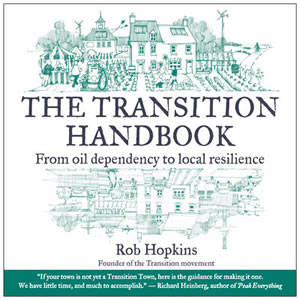At last, here is a book about our common future that we don’t have to be afraid to read. Written by “transition movement” founder Rob Hopkins, The Transition Handbook offers an inspiring and practical blueprint for community-based action in response to the challenges of climate change and peak oil.
At last, here is a book about our common future that we don’t have to be afraid to read. Written by “transition movement” founder Rob Hopkins, The Transition Handbook offers an inspiring and practical blueprint for community-based action in response to the challenges of climate change and peak oil.
Hopkins argues that changes affecting every aspect of our lives are coming, whether we want them to or not. Given continuing inertia on the part of governments, we can either plan for those changes where we can have the most impact – in our communities – or passively succumb to whatever fate awaits us.
Scientists have painted a picture of what that fate might look like, and it isn’t very pretty. According to Hopkins, climate change is only half the picture. He makes the case that our lives have been shaped by 150-plus years of cheap oil, that the end of this age is just around the corner, and that there “is no adequate substitute for those [cheap, energy-dense fossil fuels] on the scale we use them.”
Increasing community resilience, writes Hopkins, is the only protection against the certain impact of an energy-scarce future. In the event of food and oil shortages, a resilient community would be self-reliant. By using local resources and producing locally what it really needs – food, medicines, housing, energy – such a community could stave off collapse. This would require planned relocalization and “re-skilling,” which involves teaching and learning practical skills that sustain life, such as growing and preserving food. “With that resilience in place,” Hopkins writes, “if computers and toilet brushes stop coming in, we’ll still have sufficient food, shelter, fuel, basic goods and medicines to get by. Things would not be ideal from our current-day perspective, but neither would they be catastrophic.”
Building that resilient local community is the main focus of The Transition Handbook. Hopkins argues that creating an “irresistibly” compelling vision of a powered-down future – one that is more connected and more enriching than the present – will help communities identify the steps they need to take to create it. Bringing a community together to create a positive vision for their shared future (and a transition timeline for realizing it) can also succeed where conventional environmentalism has so often failed: galvanizing ordinary citizens to become part of the process.
Since it began in the UK less than five years ago, the transition movement has gone global with 278 officially designated “transition towns” formed in 15 countries, including 13 in Canada. Currently, thousands of communities worldwide are looking to start their own transition initiative. Most take direction and inspiration from the original transition town of Totnes, UK, which describes itself as “a community in the process of imagining and creating a future that addresses the twin challenges of diminishing oil and gas supplies and climate change, and creates the kind of community that we would all want to be a part of.”
Transition proponents recognize that without the participation of a critical mass of ordinary people, sustainable solutions to the challenges of climate change and diminishing energy supplies will not be possible. According to Hopkins, “unleashing the creative genius” of a community involves reaching beyond the existing groups that work on climate change and sustainability issues, to include an ever-widening circle of community members.
The transition approach is not prescriptive, but instead acts as a catalyst for communities to explore the issues and create their own unique visions for a positive post-carbon future. Hopkins argues persuasively that when communities set the agenda for energy descent, and reverse the trend of increasing energy consumption to reflect the reality of declining supplies, governments will eventually follow their lead.
While writing an “energy descent action plan” is an essential goal of each transition community, the emphasis at the outset is on raising awareness about the issues, forming working groups and initiating projects that build resilience in the local economy.
For Hopkins, the book is “an immersion in the possibilities of applied optimism.” In answering the question that it sets for itself – “What might environmental campaigning look like … if it strove to inspire, enthuse and focus on possibilities rather than probabilities?” – The Transition Handbook offers a new paradigm for environmental action that is inspiring communities around the world.
The Transition Handbook: From Oil Dependency to Local Resilience, Rob Hopkins, White River Junction, Vermont: Chelsea Green Publishing Company, 2008, 240 pages
This review originally appeared in New Eco Books, Issue 36.3. Subscribe now to get more book reviews in your mailbox!
Reviewer Information
Leslie Wallace is a writer and environmentalist who lives on Salt Spring Island, BC.













